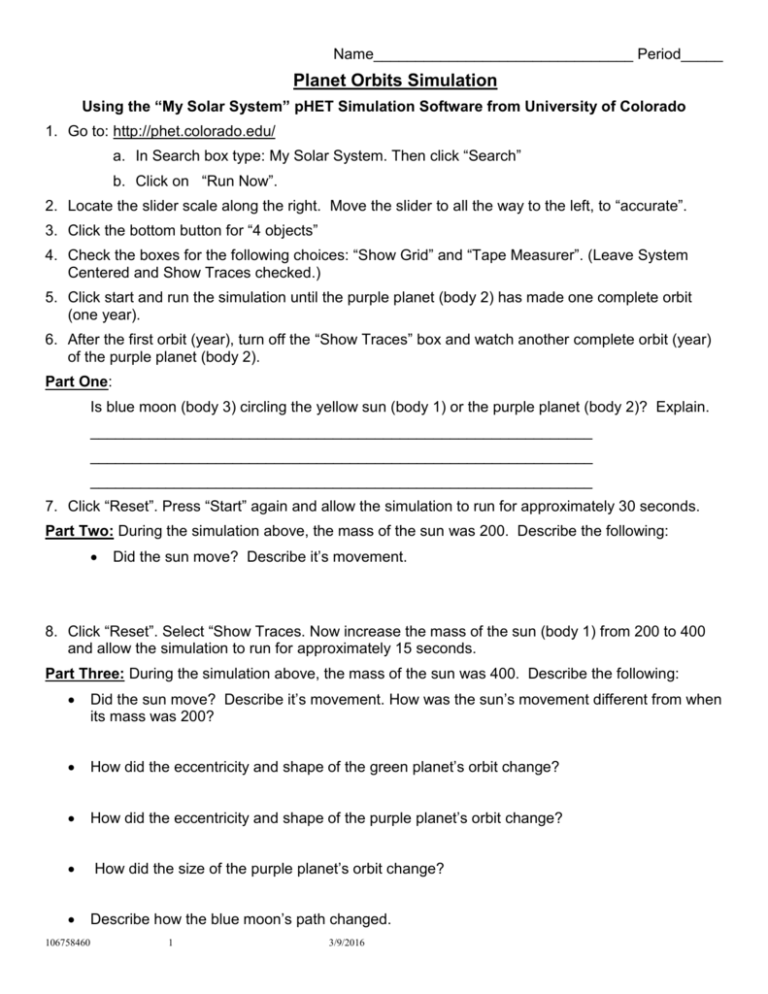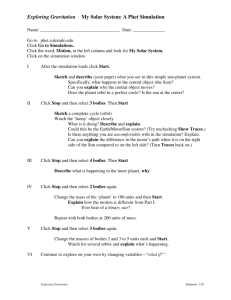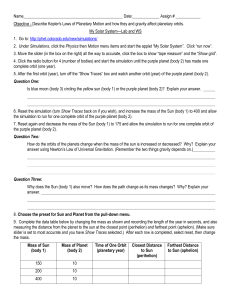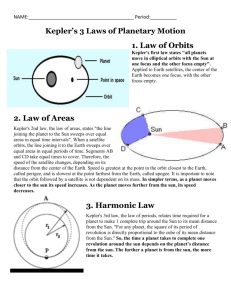Lab: Planet Orbits pHET Simulation
advertisement

Name_______________________________ Period_____ Planet Orbits Simulation Using the “My Solar System” pHET Simulation Software from University of Colorado 1. Go to: http://phet.colorado.edu/ a. In Search box type: My Solar System. Then click “Search” b. Click on “Run Now”. 2. Locate the slider scale along the right. Move the slider to all the way to the left, to “accurate”. 3. Click the bottom button for “4 objects” 4. Check the boxes for the following choices: “Show Grid” and “Tape Measurer”. (Leave System Centered and Show Traces checked.) 5. Click start and run the simulation until the purple planet (body 2) has made one complete orbit (one year). 6. After the first orbit (year), turn off the “Show Traces” box and watch another complete orbit (year) of the purple planet (body 2). Part One: Is blue moon (body 3) circling the yellow sun (body 1) or the purple planet (body 2)? Explain. ____________________________________________________________ ____________________________________________________________ ____________________________________________________________ 7. Click “Reset”. Press “Start” again and allow the simulation to run for approximately 30 seconds. Part Two: During the simulation above, the mass of the sun was 200. Describe the following: Did the sun move? Describe it’s movement. 8. Click “Reset”. Select “Show Traces. Now increase the mass of the sun (body 1) from 200 to 400 and allow the simulation to run for approximately 15 seconds. Part Three: During the simulation above, the mass of the sun was 400. Describe the following: Did the sun move? Describe it’s movement. How was the sun’s movement different from when its mass was 200? How did the eccentricity and shape of the green planet’s orbit change? How did the eccentricity and shape of the purple planet’s orbit change? How did the size of the purple planet’s orbit change? Describe how the blue moon’s path changed. 106758460 1 3/9/2016 9. Click “Reset” and decrease the mass of the sun (body 1) to 175 and allow the simulation to run for approximately 30 seconds. Part Four: Using the questions in Part Three above, write a paragraph recording your observations with the sun’s mass at 175. Part Five: How do the orbits of the planets change when the mass of the sun is increased or decreased? Why does it change? Explain your answer. ____________________________________________________________ ____________________________________________________________ ____________________________________________________________ ____________________________________________________________ Part Six: The Sun (body 1) follows a circular path. How does the path of the Sun change as its mass changes and increases or decreases? Why do you think that happens? ____________________________________________________________ ____________________________________________________________ ____________________________________________________________ 106758460 2 3/9/2016 Sun & Planet PhET Simulation 10. Click reset. Click the arrow next to the “Select Preset” Dropdown Box at top right. Choose “Sun and Planet” from the pull-down menu. 11. Complete the data table below by changing the mass as shown and recording the length of the year in seconds, and also measuring the distance from the planet to the sun at the closest point (perihelion) and farthest point (aphelion). (Make sure slider is set all the way to the left at “Accurate” – this will slow it down to enable more accurate readings.) a. Suggestion: Press stop when the purple planet has returned to its starting place. b. Record the time as indicated in bottom right of screen. c. To determine the distance, click on the tape measure to move it and lengthen it. (Be sure to put the “red x” in the center of each body.) Mass of Sun (body 1) Mass of Planet (body 2) 200 10 400 10 1000 10 200 1 200 20 200 100 200 200 Time of One Orbit (planetary year) Closest Distance to Sun (perihelion) Farthest Distance to Sun (aphelion) Part Seven: When does a planet move the fastest in its orbit? Why? ____________________________________________________________ ____________________________________________________________ Part Eight: What makes the length of the year increase and decrease? Why? ____________________________________________________________ ____________________________________________________________ ____________________________________________________________ Part Nine: A planet in a circular orbit would always be the same distance from the sun. What do you notice about orbits with the shortest years? Why? ____________________________________________________________ ____________________________________________________________ ____________________________________________________________ 106758460 3 3/9/2016 Ellipse Simulation 12. Click “reset”. Choose the ellipses preset from the pull-down menu. 13. Run the simulation until the purple planet (body 2) returns to its starting point (one planetary year) & record the time. Do NOT reset, just press stop. 14. Press start again and continue the simulation until the blue planet (body 3) returns to its starting point (one planetary year) & record the time. Do NOT reset, just press stop. 15. Press start again and continue the simulation until the green planet (body 4) returns to its starting point (one planetary year) & record the time. Do NOT reset, just press stop. 16. Measure the distances for each planet. Planet Time of One Orbit (planetary year) Closest Distance to Sun (perihelion) Farthest Distance to Sun (aphelion) Purple Planet (body 2) Blue Planet (body 3) Green Planet (body 4) Part Ten: How does the year of a planet closer to the sun compare with one that is farther away? Why? ____________________________________________________________ ____________________________________________________________ ____________________________________________________________ Part Eleven: In your own words describe what an orbit is and what factors affect the size and time (period) of an orbit. ____________________________________________________________ ____________________________________________________________ ____________________________________________________________ 106758460 4 3/9/2016









